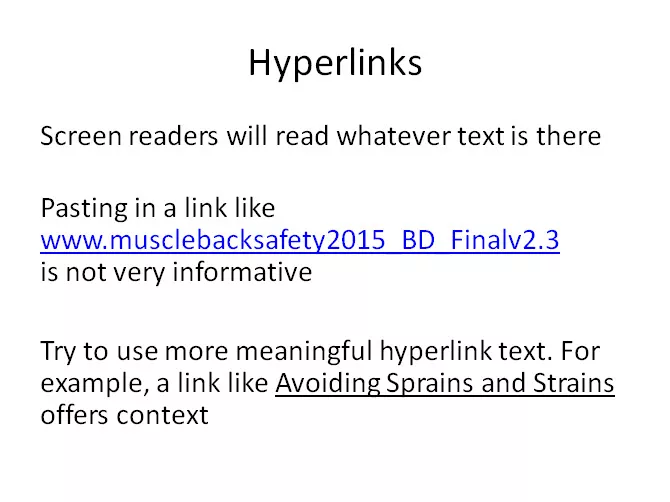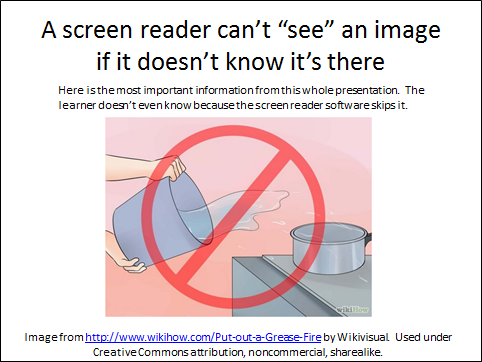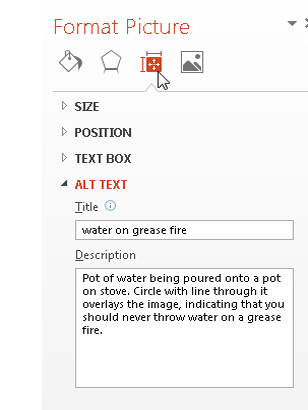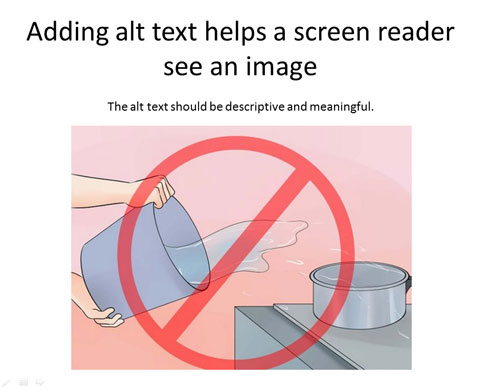Jane Bozarth’s Designing for Accessibility
In talking about material for learners who have visual impairments, I hear people use terms like “material is accessible to screen reader software” without really understanding what that means. Technically, yes, it means the material can be read aloud by the software. But is the experience learner-friendly? And are we sure important information is conveyed? Click on the audio examples below to hear what the screen-reading user hears. These were captured from the JAWS (Job Access with Sound) screen reader tool.
Screen reader software provides a literal reading of text on the screen:

Don’t forget to add descriptive alternative text (“alt text”) to images, icons, and buttons, or the screen reader will just skip them. This example shows an image with no alt text:

To add alt text, right-click on the image and choose “Format Picture”:

Here’s the same image with alt text added:

…And did you know some people use screen reader software to export material not as audio but as Braille?
Recognize that there are reasons other than visual impairment that might cause a learner to prefer the audio version of a program. Consider, for instance, issues with dyslexia, literacy skills, working in other languages. Some people, like those with a long commute, might appreciate the option to listen. Try to make the experience as useful as possible for all learners, not just “compliant” for the few.
You can test these for yourself with free versions of JAWS (limited; requires restart every time you launch it), NVDA (for Windows; free download to machine or memory stick), and WebAim. Those who use Mac and iOS device will find the VoiceOver screen reader already built in; sometimes using these can affect the way you navigate devices, so read up before turning the features on.
Also, understand that “visual impairment” occurs on a long continuum. Only about 60 percent of the people with visual challenges even use screen readers. In my world the more common technologies used are screen magnifiers, either those embedded in software like Word, in devices like iPads, or in most browsers, or in separate products like ZoomText. Using these can push content or items like navigation buttons off the screen. Still other people struggle with colorblindness or issues with contrast.
Check Your Work
I’ve talked only about materials for those with visual challenges. But don’t overlook the needs of those who may need some support in hearing or navigating your programs. Briefly: Can everyone who wants to access your course see it and /or hear it and/or navigate through it? The Texas Department of Health and Human Services offers great resources for those wanting to learn more. There’s also an excellent checklist for ensuring that your e-Learning programs are accessible.

Jane Bozarth has been a training practitioner for more than 20 years. Her specialty, finding low-cost ways of creating or purchasing quality e-Learning solutions, led to the publication of E-Learning Solutions on A Shoestring in 2005. Since then she has produced two editions of Better than Bullet Points Creating Engaging e-Learning with PowerPoint, as well as From Analysis to Evaluation, and her latest, Show Your Work. Dr. Bozarth’s dissertation focused on social learning and communities of practice, which informed her bestselling Social Media for Trainers. She is an e-Learning Guild Master and the recipient of a LOLA award, a Training Magazine Editor’s Pick Award, NASPE’s Rooney Award for innovation in government service, and an NC State University Distinguished Alumni Award. You can find her most Thursdays (8:30-9:30 pm ET) helping to moderate Twitter’s popular #lrnchat.


